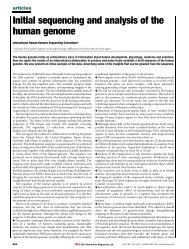2006. évi 1. szám - Jura - Pécsi Tudományegyetem
2006. évi 1. szám - Jura - Pécsi Tudományegyetem
2006. évi 1. szám - Jura - Pécsi Tudományegyetem
You also want an ePaper? Increase the reach of your titles
YUMPU automatically turns print PDFs into web optimized ePapers that Google loves.
82<br />
Kitti Maros: Research on peyotism from a legal anthropological aspect<br />
understanding of Native American approaches to<br />
mental health and child rearing, the role of ritual in<br />
the evolution of human societies, and the federally<br />
recognized role of Peyote Ceremonies in contemporary<br />
healthcare services on Indian reservations.<br />
Calab reses oppinion is, that the fact ignoring of this<br />
consensually validated knowledge, is curious at best,<br />
but more likely an inexcusable abuse of power.<br />
As Lawson and Morris (1991) point out, there is<br />
an „unavoidable hypocrisy” in the Smith case that<br />
derives from the fact that both the State of Oregon<br />
and the federal government continue to profit from<br />
the sale of alcohol and are now attacking a major<br />
source of strength that Indians have found in their<br />
own efforts to combat alcoholism. Alfred Smith was<br />
employed by a substance abuse treatment program<br />
and was a member of the Native American Church<br />
and there is no contradiction between these two roles.<br />
If his employers were truly interested in providing<br />
culturally relevant services for Native American<br />
clients, they would have found out that the Native<br />
American Church’s approach is one of the most successful<br />
in this area, recognized by the Indian Health<br />
Service and a host of scholars.<br />
This paper has argued that, the Smith case did not<br />
simply involve freedom of religion but also freedom<br />
of culture (e.g. raising one’s children using traditional<br />
methods) and freedom of therapy (implicating a medical<br />
autonomy right). Freedom of therapeutic modality<br />
is a new concept but one that follows from the view<br />
that human societies have developed unique ways of<br />
understanding and adapting to their environments<br />
and sustaining mental health. These adaptations have<br />
included psychopharmacological traditions that cannot<br />
be reduced to „drug use”.<br />
The Native American Church is considered a<br />
mental health system with a ritual pharmacological<br />
intervention, an associated aftercare plan, a support<br />
network involving a community of non-abusers,<br />
and a philosophy of life. In either case, outlawing<br />
this tradition is thus unethical from a clinical and<br />
human rights point of view because it amounts to<br />
the disruption of a functioning therapy. If we remove<br />
the Native American’s right to use Peyote, we will<br />
destabilize a fragile mental health equilibrium for<br />
hundreds of thousands of Native American people.<br />
The objective of this part of my paper was to<br />
maintain, with arguing in favor of Calabrese’s<br />
hypotesis,that the therapeutic nature of this ritual<br />
peyote use can be revealed. My main concern was<br />
that the potential therapeutic efficacy of ceremonial<br />
use manifests through its symbolism in a feedback<br />
process.In my interpretation the ritual peyote use<br />
must be viewed through the lenses of the homo<br />
religioso. In this context, ritual peyote use is considered<br />
in terms of exclusive mental health adaptations<br />
including symbols to support socially valued pattern<br />
of ceremonial experience, self-awareness and<br />
emotional control. The meaning of the ceremony<br />
is embedded in its symbolism: the potential therapeutic<br />
significance is not solely contingent upon its<br />
psychoactive action or sociological features, but it<br />
also manifests in the symbolism. The life-course of<br />
the individual is symbolized in the ritual, and furthermore,<br />
it is embedded in a symbolic context that<br />
highlights the natural transformative processes of<br />
birth, the changing of the moon, and the dawning of<br />
a new day. That is to say, the symbolism of the ritual<br />
and the benevolent therapeutic efficacy of it are in<br />
a complementary distribution; they function within<br />
the framework of a feedback process. Therefore, the<br />
symbolism in peyote rite acts as the very vehicle of<br />
the ritual procreation of self-awareness, which, in<br />
turn, is a tool of the potential therapeutic efficacy of<br />
ceremony. Moreover, as I have proved, peyote bears<br />
dual significance in this concept and it is regarded<br />
as omniscient and omnipresent. This omniscience<br />
and omnipresence manifests and is perceived by<br />
the members universally; this characteristic feature<br />
helps the adherents of the Native American Church<br />
to combat excessive drinking.<br />
IV. Conclusion<br />
In the abstract of my essay I wrote about my intention<br />
to point out the significance of the investigations<br />
of legal anthropologists: how important the resarch<br />
on the problems of the ethnic and the religious minorities<br />
can be from the legal aspect. The case of Mr.<br />
Smith, which caused upheavel in the society and devided<br />
the legal community, reflects on the difficulty,<br />
that the rigid implementation of the law should be<br />
avoided, thus the adjustment of the rules to everyday<br />
life is indispensable. The achievements of the legal<br />
anthropological research methods are necessary in<br />
the legal practice: to enlighten the social aspects of<br />
various defects of legal practice. In the future, the<br />
courts will likely be called to decide on many cases<br />
dealing with the rights of minority subcultures, and<br />
it might be better if the courts took into concideration<br />
the anthropological knowledge, so they would not<br />
accused of abuse of power.<br />
Reference List<br />
Albaugh, Bernard J. “Peyote in the Treatment of<br />
Alcoholism Among American Indians,” .American Journal of<br />
Psychiatry 131:1247-1250.<br />
Anderson, Edward, F. “Ethnobothany of Peyote”.<br />
Available:<br />
http://www.erowid.org/plants/peyote/peyote_<br />
JURA 2006/<strong>1.</strong>
















